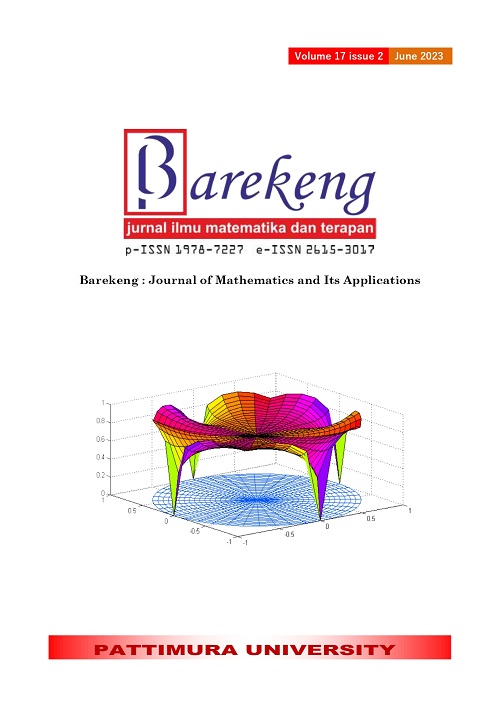PREMIUMS CALCULATION OF TERMINAL ILLNESS INSURANCE
Abstract
One related type of critical illness insurance is Long Term Care (LTC) Insurance. This study discusses the calculation of LTC insurance premiums with an annuity as a rider benefit. The benefit is included the cost of insurance care when diagnosed with a critical illness with a terminal condition or death because of any reason. The types of critical illnesses used in this study are cancer, heart disease, stroke, and diabetes mellitus. The data used are in the form of Indonesia's mortality table, and data on the prevalence of critical illness patients with terminal illness conditions. The net annual premium value in this study was obtained through the results of the multiple-state model determination of the transition probabilities of 10 states. The transition probability of an insured candidate is obtained from the prevalence of critical illness patients and the prevalence of mortality. Based on the case study, the amount of net annual premium that must be paid by an insured female aged years in good health is for the protection period and the payment period is years. The cost of insurance premiums for the male insured is greater than for the female insured. The higher the interest rate used, the smaller the net single premium that must be paid. The younger the age when registering the policy, the smaller the premium that must be paid. The longer the coverage period, the greater the premium that must be paid. This result is expected to be a recommendation for the prospective insured to adjust the suitable premium.
Downloads
References
Aprijon, “Perhitungan Cadangan Premi Menggunakan Metode Premium Sufficiency Pada Asuransi Jiwa Berjangka,” Jurnal Sains Matematika dan Statistika, vol. 6, pp. 124-132, 2020.
B. Indonesia, “Siaran Press, BI-7 Day Reverse Repo Rate Naik 25 BPS Menjadi 3.75% Sinergi Menjaga Stabilitas Dan Memperkuat Pemulihan,” Bank Indonesia, September 2022. [Online]. Available: https://www.bi.go.id/id/publikasi/ruang-media/news-release/Pages/sp_2422622.aspx. [Accessed 4 September 2022].
C. P. Gumauti, Y. Wilandari and R. Rahmawati, “Perhitungan Premi Asuransi Long Term Care untuk Model Multi Status,” Jurnal Gaussian, vol. 5, no. 2, pp. 259-267, 2016.
E. Espinoza, “Penentuan Premi Bulanan Asuransi Kesehatan Berjangka Perawatan Rumah Sakit untuk Perorangan,” Jurnal Matematika UNAND, vol. 5, pp. 30-35, 2016.
F. Baione and S. Levantesi, “A Health Insurance Pricing Model Based on Prevalence Rates: Application to Critical Illness Insurance,” Insurance: Mathematics and Economics, vol. 58, pp. 174-184, 2014.
Haryono and J. Ratnaningsih D, Pengantar Proses Stokastik, Tangerang Selatan: Universitas Terbuka, 2018.
Irwan, Didiharyono and Maulidina, “Metode Markov Chain untuk Menghitung Asuransi pada Pasien Demam Berdarah Dengue,” Al-Khawarizmi: Jurnal Pendidikan Matematika dan Ilmu Pengetahuan Alam, vol. 7, pp. 151-160, 2019.
K. K. R. Indonesia, Laporan Nasional RISKESDAS 2018, Lembaga Penerbit Badan Penelitian dan Pengembangan Kesehatan, 2019.
K. K. R. Indonesia, “Kebijakan Perawatan Paliatif Menteri Kesehatan Kesehatan Republik Indonesia”. Indonesia Patent 812/MENKES/SK/VII/2007, 2007.
M. Ajib, Asuransi Syariah: Ebook, Jakarta: Rumah Fiqih Publishing, 2019.
T. Konetzka R, “Long Term Care Insurance,” in Encyclopedia of Health Economics, ed A.J. Culyer, pp. 152-159, 2014.
Suryanto, Manajemen Risiko dan Asuransi, Tangeran Selatan: Universitas Terbuka, 2019.
S. Haberman and E. Pitacco, Actuarial Models for Disability Insurance, Florida: CRC Press, 1998.
T. Futami, Matematika Asuransi Jiwa Bagian I, Herlianto G. (alih bahasa)., Japan: Incorporated Foundation Oriental Life Insurance Cultural Development Center, 1993.
W. H. Organization, “Press Release, International Agency for Research on Cancer,” 2018. [Online]. Available: https://www.iarc.who.int/wp-content/uploads/2018/09/pr263_E.pdf. [Accessed 10 4 2022].
Copyright (c) 2023 Neva Satyahadewi, Hani Dwi Retnani, Hendra Perdana, Ray Tamtama, Siti Aprizkiyandari

This work is licensed under a Creative Commons Attribution-ShareAlike 4.0 International License.
Authors who publish with this Journal agree to the following terms:
- Author retain copyright and grant the journal right of first publication with the work simultaneously licensed under a creative commons attribution license that allow others to share the work within an acknowledgement of the work’s authorship and initial publication of this journal.
- Authors are able to enter into separate, additional contractual arrangement for the non-exclusive distribution of the journal’s published version of the work (e.g. acknowledgement of its initial publication in this journal).
- Authors are permitted and encouraged to post their work online (e.g. in institutional repositories or on their websites) prior to and during the submission process, as it can lead to productive exchanges, as well as earlier and greater citation of published works.






1.gif)



